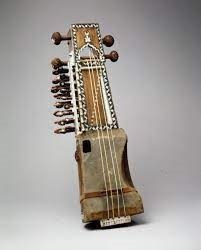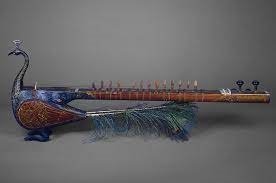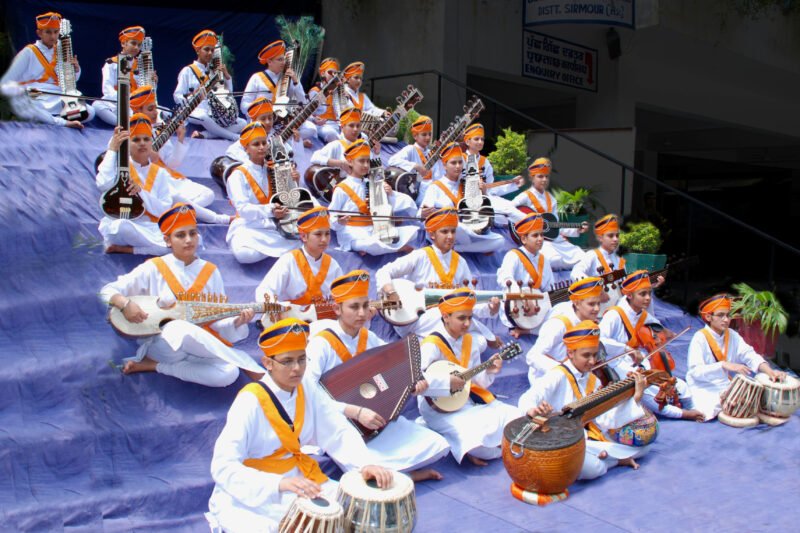Guru Arjan Dev recorded in the Holy Guru Granth Sahib the sermons of various visionary spiritual saints, apart from the verses of the Gurus, to establish the concept of the universal vision of the Almighty. The singing of the spiritual message of these visionaries included in the Holy Guru Granth Sahib according to different ragas is considered as the tradition of Gurmat Sangeet. Guru Nanak sang Gurbani in a very refined and rich voice while Bhai Mardana played Rabab. This, we may say, was the beginning of Gurmat Sangeet.
Guru Nanak, the dispeller of darkness, performed miraculous deeds of benevolence to liberate the people from the vagaries of religious hypocrisies and barren pieties. He led them on the path of purity and truth and blessed them with the wondrous gift of Hari Kirtan, a simple means of attaining Oneness with the Almighty.
The prevailing faiths had laid down arduous paths of Hatth Yoga and other crooked rituals to get close to God. They also aimed at attaining superpowers to display miracles and indulged in idle speculation of metaphysics. Guru Nanak clarified that ‘miracles are the relishes for others’ and taught us that the merger of the human soul in the larger soul of the Almighty is the true goal of life.
Instead of singing absurd songs and meaningless couplets, Guru Nanak envisaged the Gurbani in the musical format of the classical Indian tradition. By performing Gurbani Kirtan several human beings became visionaries and innumerable dacoits, thieves and cruel emperors became human beings in the true sense of the word.

Universal Vision of the Almighty
Guru Arjan Dev recorded in the Holy Guru Granth Sahib the sermons of various visionary spiritual saints, apart from the verses of the Gurus, to establish the concept of the universal vision of the Almighty. The singing of the spiritual message of these visionaries included in the Holy Guru Granth Sahib according to different ragas is considered the tradition of Gurmat Sangeet. This pattern of the singing of Hari Jas has emerged in the form of a distinct musical tradition.
Assuming power, the primal Being Himself has entered into the world in the form of True Guru (Guru Granth Sahib 1395). Guru Nanak sang Gurbani in a very refined and rich voice while Bhai Mardana played the rabab. This, we can say, was the beginning of Gurmat Sangeet. He sang the Gurbani in 19 ragas. Following him, Guru Angad Dev, Guru Amar Dass, Guru Ram Dass, Guru Arjan Dev and Guru Tegh Bahadur also sang their own verses of Gurbani in different ragas. The entire Gurbani has been arranged in Guru Granth Sahib in 31 ragas. Guru Gobind Singh further enriched and expanded the orbit of Gurmat Sangeet by writing many shabads of Gurbani in several more poetic and musical traditions.
Springs of Spiritual Music
The sprouting of a raga is the outcome of God’s own spiritual gift which flourishes in an individual. For this reason, a Brahm Giani and a Visionary do not need to learn the art of singing. Ragas grow like springs from within the spirit of a blessed singer. For instance, there is no record in history that any of the Gurus learnt the art of singing from some one else. It confirms that all the Gurus were themselves the springs of singing spiritual music.
In the context of the above observation, innumerable instances have been recorded from the life of Sant Attar Singh of Mastuana. One day, while in Tarn Taran, Sant ji was engrossed in the singing of Kirtan. Bhai Deedar Singh came to the

congregation. The raga being sung by Sant Ji was not according to the time of the day. It occurred to Deedar Singh that Sant Ji does not have knowledge of the raga. He recites Kirtan without keeping in mind the time of the day specified for a raga. Sant ji quickly completed the shabad and sang another shabad which was according to the specific time of the day. Deedar Singh was spellbound. When Sant Ji completed the Shabad, he casually observed, “Bhai, humble servants who sit on Guru Nanak’s door do not need to learn ragas. This blessing is showered on them in their sleep”.
Once Sant Ji was travelling from Baramula to Srinagar. Famous scholar, Bhai Kahan Singh happened to be there. He has portrayed the scene in his own pen: “The entire Sikh sangat has heard the delightful Kirtan sung by Sant Ji in his unique melodious voice. There was a deep impact of his singing on the minds of the entire Sangat. Knowing that I was a connoisseur of ragas, he said softly in my ear that I sing these shabads to involve the entire sangat in the spirit of the Kirtan. If you so desire I shall sing a shabad in a proper raga. Saying this, he sang one shabad in raga Marwa in four taal and another shabad in raga Poorya in three taal. He sang these shabads in such exquisite tune and voice that his godly spiritual voice still rings in my ears. Sant ji was a spiritual genius, a perfect Bhakt of the Almighty, an incessant reciter of Naam, a perfect connoisseur of ragas, dedicated to selfless service, generous and large-hearted, broad-minded and a symbol of humility. Such superhuman personalities emerge on the horizon of the world for the welfare of the people only on rarest of rare occasions.”
Once Sant Ji went to Sialkot, where his dera used to be at Babe Di Ber. The next day early in the morning a programme of Anand Karaj had been arranged. Bhai Jawala Singh Ragi performed the Asa Di Vaar Kirtan. Usually, Sant Ji experienced a powerful urge to perform Kirtan so that every pore of his body was involved in his singing. But on that day Sant Ji sat in samadhi, eyes closed, like an ardent listener, involved in the delightful Kirtan. When Asa Di Vaar Kirtan was completed, Sant Ji opened his eyes and said, “Bhai, this is the dedication of mind.” Bhai Jawala Singh stood with folded hands, his head bent in reverence before Sant Ji and said, “This is just your blessings and kindness. When we were young we used to perform Kirtan when you visited Tarn Taran and stayed at Mai Ram Kaur’s Bunga. One day you directed and fixed your kind sight on me and it is that one benevolent sight of yours that brought in me the talent of Kirtan.
When Sant Ji went on a tour of the Malwa area of Punjab, where villagers used to sing indecent songs and sayings in their gatherings around the chaupals, he used these very popular tunes to sing Gurbani and involved the entire sangat in singing these shabads. Simple people of villages followed these familiar and simple tunes and got involved in Gurbani. Before this tour, Sant Ji often performed Kirtan in ragas.
The unheard melody The tradition of Gurmat Sangeet is quite different from that of the other systems of music. Its main aim is to transform the obviously audible music into inaudible inner spiritual music, the unheard melody, which also involves the progressive enrichment of the soul by absorbing the Words of the Gurus. Involvement in the unheard melody of the Word is the primary objective of the Gurmat Sangeet. In other musical systems, it is the raga which dominates, and the listener only enjoys its intricacies and its sweetness of sound, without his soul being involved.

Guru Nanak often said, “Mardana, play the rabab, Almighty’s message is being revealed through the Baani.” Thereafter he would start singing Gurbani and Mardana would tune his rabab according to the raga. During the time of Guru Angad Dev, Bhai Shajada would play rabab while Guru Ji sang Gurbani in ragas. During the time of Guru Amar Dass and Guru Ram Dass the rabab players from the family of Mardana, Bhai Banu and Bhai Saloo played on rabab and Guru Ji sang Gurbani in ragas
In Guru Arjan Dev’s darbar Bhai Balwanda and Bhai Satta paid rabab while Guru Sahib sang Gurbani in ragas. They also performed Kirtan in Guru Ji’s darbar. Guru Arjan Dev got a unique string instrument made, called Saranda, with which he performed Kirtan in Darbar Sahib, Amritsar. Guru Sahib laid the path for the Sikh tradition that Gursikhs must play the musical instruments themselves and should not depend upon a professional ragi for Kirtan. During the time of Guru Hargobind, Bhai Babak was the regular rabab player performing in Darbar Sahib. Although Guru Hargobind did not contribute any Gurbani himself, to infuse enthusiasm among the warriors, he got heroic ballads were written which were sung by the ballad singers. He also sang Hari jas with rabab. After that, the Gursikhs started singing Gurbani accompanied by string instruments. Guru Gobind Singh performed Kirtan while playing another unique musical instrument called Taaus. He used to sing Hari jas Kirtan on rabab also. Following this, the Gursikhs adopted string instruments for performing Kirtan in the company of Saadh Sangat.
Sant Baba Sham Singh of Amritsar performed Kirtan on stringed instruments for nearly 78 years at Harmandir Sahib, Amritsar. During the Twentieth Century, i.e. after a few years, the ragis started performing Kirtan with Harmonium. It is believed that Harmonium was developed from the piano during the middle of the Nineteenth Century by an Italian musician. The most exalted is the singing of The Lord’s praise in this age of Darkness. (1075) In the age of Kalyug, Kirtan has a special role to play.

Only the fortunate ones get their spiritual selves engrossed in Naam Simran, the divine remembrance. Even when they succeed in doing so, the spontaneous inspiration is disrupted after some time. For this reason, Guru Ji has blessed the Saadh Sangat with the invaluable art of Kirtan so that when their minds tend to wander away from Naamsimran. Saranda would get involved in Kirtan. Guru Arjan Dev sang with a Saranda. In Kalyug individuals have extroverted outlooks which make them frivolous and they tend to seek more and more worldly comforts. Their minds tend to splinter easily. Only rare, fortunate individuals with the virtue of truthfulness can hope to rise above worldly temptations and turn inward looking. They then get involved with the Shabad-Guru and enjoy its spiritual bliss.
Guru Nanak’s doctrine – Guru’s Word sung by a songster fills the soul of the Gursikh – (Shabad Guru Surat Dhun Chela) and leads the individual from the worship of his body to spontaneous involvement with the marvellous vision of the Word. It leads him further towards the path of reaching the Almighty. The achievement of the state of one-in-all and all-in-one is so hard to materialise that an individual will find it impossible to ascend to that state in a single step. That is why the Gurus led the Gursikh to ascend this path, step by step, taking him ultimately to the ‘Khalsai’ nectar, the goal of spiritual bliss. There all search ends because the Word merges with the Panth.






